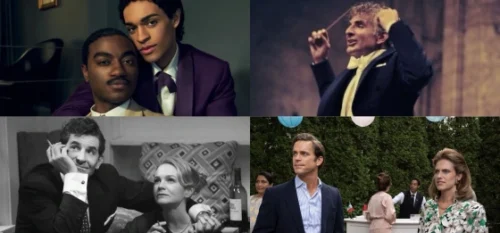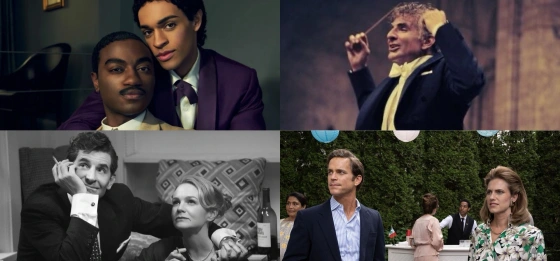
The end of 2023 promised a plethora of queer-themed film and television, with one film and one series topping the list of “most anticipated” in my queer household: Maestro and Fellow Travelers. And in some respects, we weren’t disappointed. These media narratives offered high production values, formally inventive visual storytelling, and some of the finest acting we’ve seen in decades.
Both of these shows also offer us portraits of queer life and love amidst the homophobia of the mid to late twentieth century. But as I watched and thought about the film and series, I came to feel more and more…baited — queerbaited by the representation of our own history.
Let’s start with Maestro, Bradley Cooper’s depiction of Leonard Bernstein, who was not only the first great American conductor, but a public pedagogue who brought classical music to the masses through innovative programming, championing new music, educational television, and his own delightful compositions. Bernstein’s many liaisons with men are definitely on view, but really only glancingly, with no depth at all. The relationship in particular with Tom Cothran, which has been well documented elsewhere, is presented as only a foil to Bernstein’s wife’s marital happiness.
So, if Maestro isn’t about the complexity of Bernstein’s actual life, then what is it about? Well, the film is really about Felicia, Bernstein’s wife, and then not even really about her, as much of her own complexity is left out. Instead, the film seems to use her life, particularly her understanding of her marriage, as a metonym for changing historical understandings of homosexuality.
At the beginning of their relationship, often depicted in black and white in the film, Felicia (played compellingly by Carey Mulligan) seems quite accepting of her fiancé’s, then husband’s, sexual fluidity. “I know exactly who you are,” she says in a scene in which she praises the general sexual experimentation and tolerance of post-war high cultural circles. We see Bernstein, holding his newborn child, joining fellow composer Aaron Copeland, himself queer, on a swing, the scene suggesting a relaxed environment — at least behind closed and privileged doors — with regard to sexuality. It’s all just part of the family.
As time progresses, though, attitudes about sexuality become more publicly tolerant, but we see Felicia becoming less so, more concerned, even disturbed by her husband’s relationships with other men. A more recent historical time in the film, the ‘70s, is rendered in color, with scene after scene of Bernstein starting to party it up with men, snorting lines of coke and making out with guys in hallways. Felicia is disturbed by such behavior, particularly as rumors of Bernstein’s “infidelities” start to circulate and their children are asked uncomfortable questions. But what really seems to disturb Felicia, at least as this film depicts her, is her growing sense that her husband is really just gay. In an emotionally wracking scene between the two of them, Felicia confronts Bernstein about both how he is squandering his musical gifts and isn’t being true to himself. This scene is set post-Stonewall, amidst the growing surge in gay rights, when — let’s be frank — the (closed-door) tolerances for sexual fluidity and experimentation began steadily to be replaced by the cultural adoption of a brute division of the species into gay and straight. In this context, Bernstein is just, well, gay.
The film proceeds to show him reunited with his wife during her cancer diagnosis and subsequent illness and death. In the film, Felicia is clearly the center of Bernstein’s emotional gravity. But, if you know anything about their lives, this rendering raises more questions than answers, for Maestro ultimately isn’t about Bernstein or Felicia at all; too much of their lives is left out. But what it does seem to be about is the weird way in which emerging gay identity in the latter half of the 20th century seems to make the Bernstein’s complex and, somewhat poly, marriage untenable.
Indeed, the film only ever offers glimpses of that complexity, for instance, in the scene in which Bernstein is introducing fiancée Felicia to one of his lovers, played by Matt Bomer who also appears in Fellow Travelers and whose face so poignantly and painfully renders his character’s emotions at being introduced to the person who will replace him in Lenny’s affections, sexual and otherwise. The scene is queerbaiting me, with Bomer’s beauty and with the insinuation of a queer relationship we’ll never see. As the polymorphous perversity of Bernstein’s early life (in black and white) becomes binarized into the gay/straight identities of his later life (in color), I wondered at the oddity of the choice to divide this life into a before and after, when the before seemed so much sexually and relationally richer and interesting than the full-color after. Ultimately, Maestro just gives us teasing glimpses of queerness while allowing some viewers (as they have) to interpret the film as a gay man whose closet wrecked his wife’s life.
My viewing of Maestro coincided with my finishing of the series Fellow Travelers, the latter of which is available on Showtime and Paramount+, and the concatenation of this viewing drove home how very queerbait-y this series actually is.
To be continued…
 Jonathan Alexander is Chancellor’s Professor of English at the University of California, Irvine. He is the author most recently of the scholarly study Writing and Desire: Queer Ways of Composing and the memoir Dear Queer Self.
Jonathan Alexander is Chancellor’s Professor of English at the University of California, Irvine. He is the author most recently of the scholarly study Writing and Desire: Queer Ways of Composing and the memoir Dear Queer Self.





